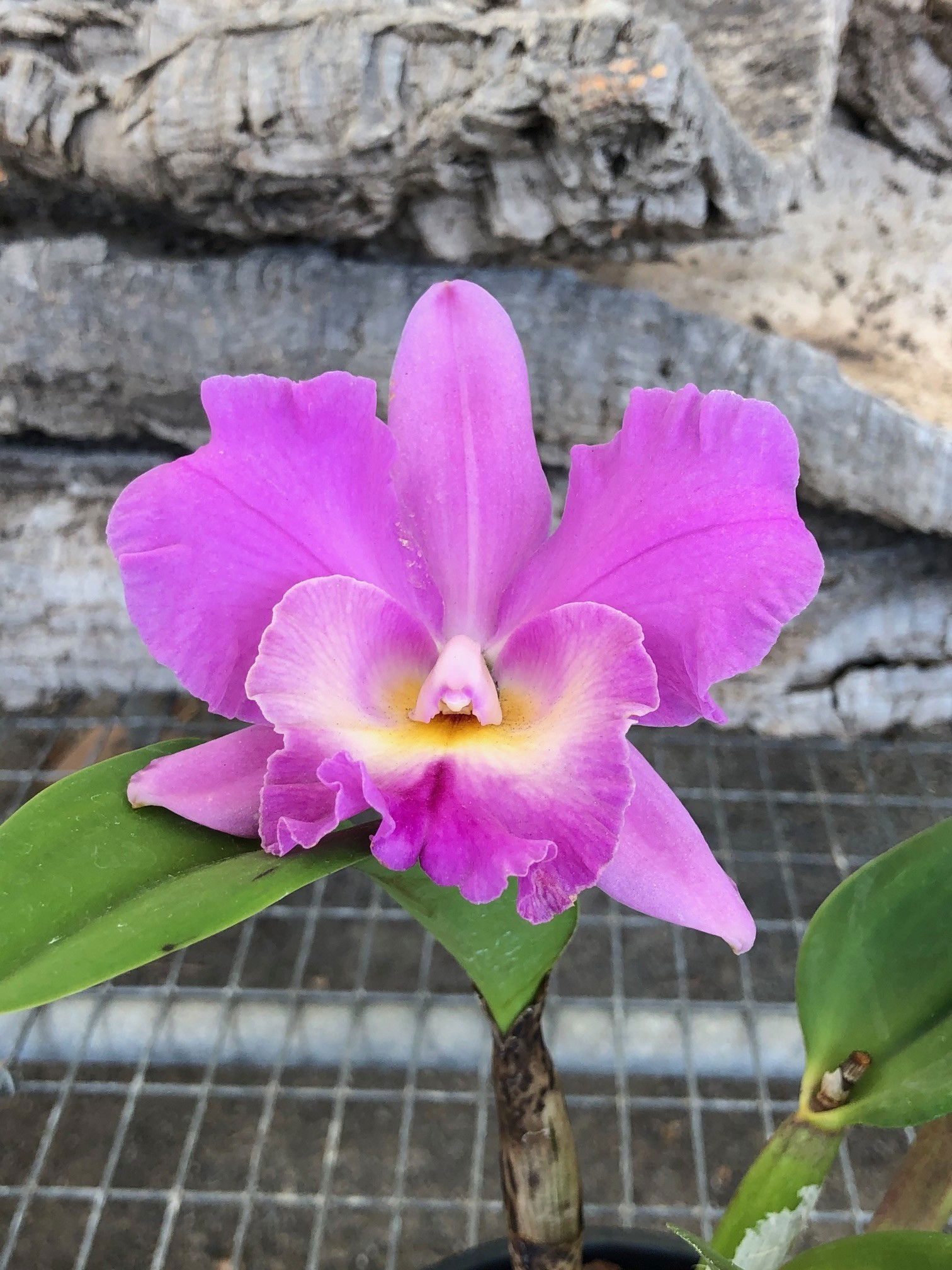
Cattleya labiata
Contents
- Top Tips
- Light, Water, Humidity & Fertilisation
- Dormancy Care & Annual Flowers
- Common Issues
- Origins, Temperature, Propagation, Repotting & Toxicity.
Need the answer to a specific plant query? Book a 1-to-1 video call with THE HOUSEPLANT DOCTOR™, the website's friendly author, to overcome and address your niggling problem! Available on iMessage, WhatsApp, Facebook Messenger & more.
Top Tips & Info
- Care Difficulty - Easy to Moderate
- Cattleya are best suited in bright, indirect settings with minimal sunlight. Never place a specimen in the excessive sun or within three metres of an operating heat source due to the heightened risk of dehydration.
- Maintain evenly moist soil by allowing the top third to dry out in between waters. Reduce hydrations further during the autumn & winter to increase the chance of flowers.
- Supplement with an Orchid-labelled fertiliser once a month, via a foliar or liquid feed.
- Scroll down to 'Dormancy Period & Annual Flowers' for information about re-blooming Cattleya in the winter months.
- Repot every three years using an Orchid Bark & a slightly larger pot, during the spring.
- Keep an eye out for Spider Mites and Mealybugs that'll locate themselves in the cubbyholes of the stems & foliage.
Location & Light - 🔸🔸
Cattleya do best in well-lit environments without excessive sunlight or dry air. Although they can withstand short periods of direct light, it's important to keep them sufficiently hydrated to downplay the risk of dehydration and sun-scorch. The ideal setting would be within a few metres of an east or west-facing window, or in a setting that a newspaper can be read without the use of artificial lighting. Those situated in darker areas will be at risk of root rot, along with the minimal chance of another bloom.
Water - 🔸
During the spring and summer months, be sure to keep the soil relatively moist, allowing the top third to dry out in between waters. Adequate hydration is paramount while the new pseudo-bulbous (basal) offsets develop, as matured stems will reward you with a winter bloom that can last several weeks each year. Periods of droughts during this development will hinder growth, along with delaying the flowering process until the subsequent year when cultivation isn't up to scratch. Reducing irrigations is necessary throughout the swing of autumn and winter to force the specimen into its dormancy, which in turn will benefit its overall health. While in bloom, be sure to keep the soil well-hydrated to lubricate the thirsty work of developing buds and inflorescences. Under-watering symptoms include sudden flower loss, wilted leaves, deformed growth and a gradual decline in health. Never allow the intense sun or forgetfulness to take over, as both will result in a premature flower loss and a weakened specimen. Over-watering symptoms include lower yellowing of leaves, a rapidly declining stem, flower loss and a rotten base (pseudobulbs). These issues are commonly down to either too much soil moisture, an incorrect soil medium, too little light, or foliage that has allowed to remain wet for long periods.
Humidity - 🔸🔸🔸
This genus of Orchids can survive in average room humidity rather well. If you live in an extraordinary dry climate (below 40%), introduce a humidity tray to counteract the chance of browning leaf-tips. Bathrooms aren't necessarily the ideal location for moist air, as the constant humidity fluctuations may anger the specimen into weak foliar growth.
Fertilisation - 🔸🔸
Orchids have open stomata, meaning that fertilisation can be achieved via foliar feeds. Spray the solution onto the leaf's topside to provide the two critical ingredients for good quality blooms (nitrogen & potassium). Although typical soil-borne fertilisers will still benefit its health, only the root caps will absorb the nutrients, meaning that excess fertiliser salts may build up after a while. Click on this link and scroll down to the 'Orchid Fertilisers' section for our recommended brands and products!
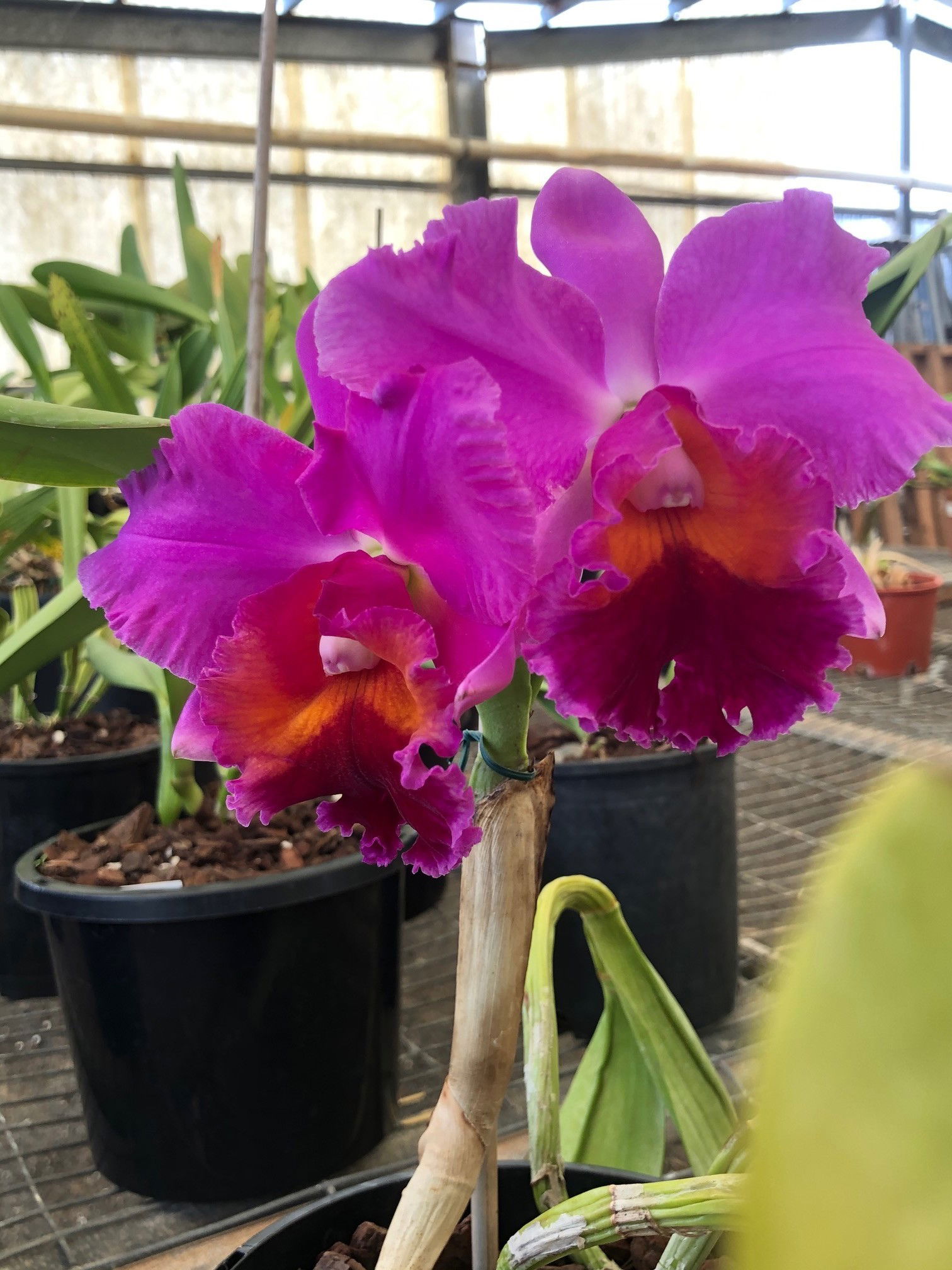 Each flower is sweetly-scented and can last up to a month in the correct cultivation.
Each flower is sweetly-scented and can last up to a month in the correct cultivation.
Dormancy Care & Annual Flowers
Cattleya inflorescences are easily achieved when its dormancy irrigations are reduced by half; those who have a cooler room without artificial light at night will also be on the upper-hand. The following steps should be performed from late summer through until early spring, when they enter their dormancy. Keep the roots pot-bound to add further stress onto the specimen, which in turn will significantly heighten the chance of flowering. Blooms will generally appear in the late autumn, but may occur at any given time.
N. B. - Each individual stem (basal offset) will only flower once, so if you only have already-flowered foliage, you'll have to wait until the following year for a new offset to appear. New stems will develop in the spring and maybe ready to bloom within the same season if your care skills are up to scratch.
Sunlight & Location
Be sure to provide a bright location with little to no direct sunlight. Although the winter rays won't necessarily hurt the plant, be careful not to fall in the trap of sun-scorch and severe dehydration.
Avoid the use of artificial lighting at night or locations that boast temperatures higher than 18℃ (64℉).
Hydration
Reduce waters so that at least half of the soil becomes dry. It's essential to keep them on the drier side to life, as they'll think that hard times are ahead and therefore will need to pass its genes on to the next generation.
Occasional Feeds
Whilst in bloom, use a Tomato feed to provide monthly nourishment of potassium; fertilisation isn't needed until the first flower stalk develops from the plant.
Reduce Everything
This is to remind you that everything needs to be reduced - especially the temperature.
Temperature
This is the most significant step; reduce the temperature down by around 5℃ compared to the summertime or place in a room that's between 12 - 15℃ (54 - 59℉). The drop in temperature should ideally last until the inflorescence finishes blooming, although it can still be transferred into the main house as long as it sits on a pebble tray. You'll be at a significant disadvantage if the ambient temperature is kept constant throughout the year, as Cattleya will only respond in locations that have fluctuations of around 7℃. Never exceed the minimum temperature as it may lead to plant death or yellowed foliage at a bare minimum.
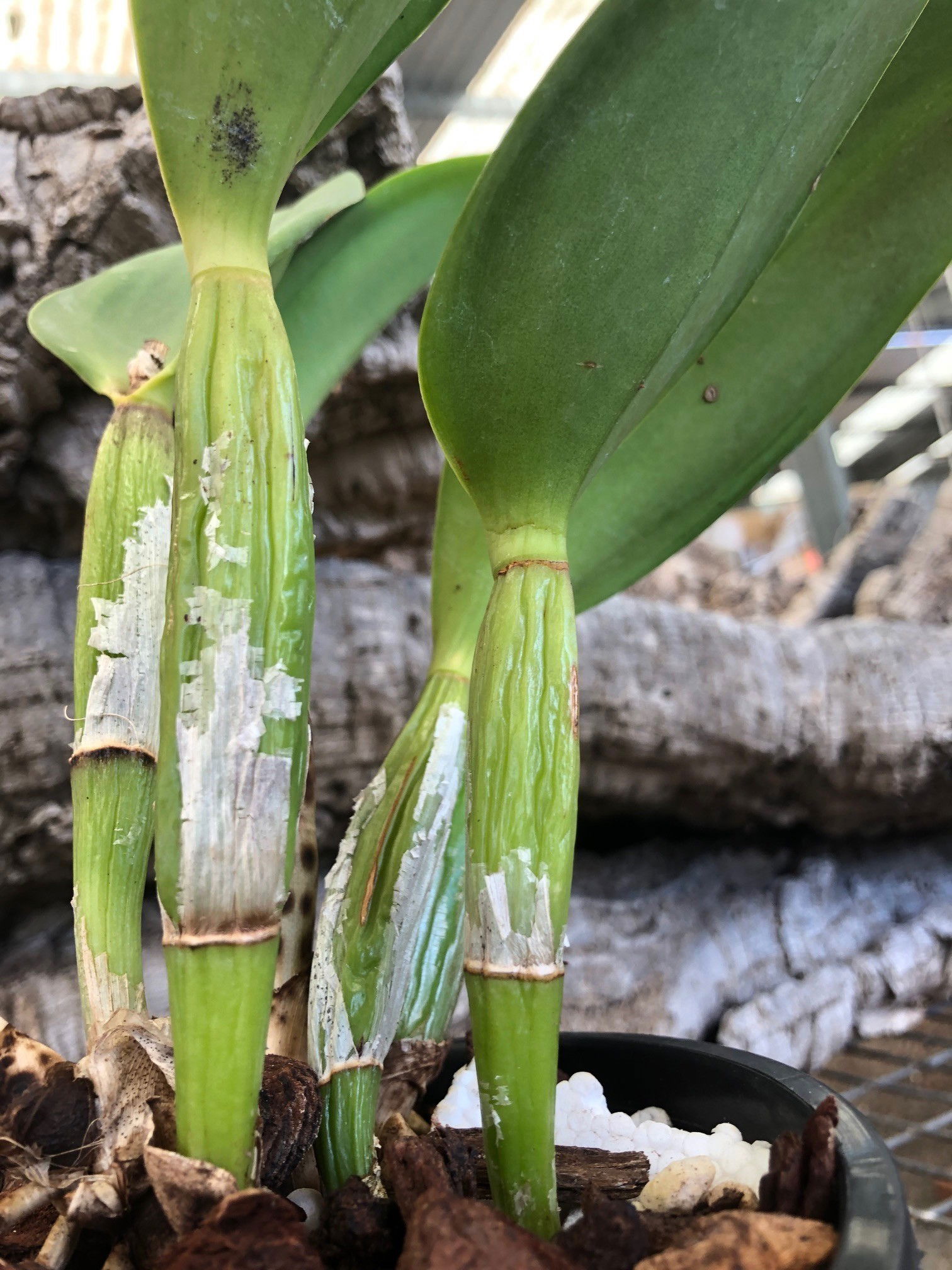 Cattleya will only bloom on the juvenile growths, with already-flowered stems collecting stored nutrients via photosynthesis.
Cattleya will only bloom on the juvenile growths, with already-flowered stems collecting stored nutrients via photosynthesis.
Common Issues with Cattleya
Directly pinpointing yellow leaves is quite hard due to the many different issues that could be at fault. Problems include watering-related abuse, too much or too little light, and fertilisation issues. If you'd like to speak to ukhouseplants regarding this issue, don't be afraid to book a 1-to-1 call with THE HOUSEPLANT DOCTOR™ to help guide you the step-by-step process!
Root rot is a common issue with specimens sat in too moist or waterlogged soil for long periods. Symptoms include rapidly yellowing leaves, stunted growth and a rotten brown base. Take the plant out of the pot and inspect health below the soil line. If the roots sport a yellow tinge, you're good to go, but if they're brown and mushy, action must be taken immediately. More information about addressing root rot can be found on this link.
A lack of flowers is caused by an insufficient dormancy period, where the temperatures are kept more or less the same over the year. Reduce the temperature by a couple of degrees over the autumn and winter months, along with fewer irrigations.
New buds won't develop on an already-flowered stem. As soon as the blooms drop off, this will spell the end of both foliar and flora growth on that particular shaft. Wait until the new stems become mature for another show of flowers - you'll know when it has reached maturity once no juvenile leaves develop at the top.
A sudden loss of older flowers with a yellowed stalk is a sign of prolonged droughts. Especially during the flowering process, near-continuous moist bark is mandatory for extended blooms; allow the roots to turn a green-greyish colour in between irrigations.
Short-lived flowers could be the product of low humidity. Place the Orchid on a humidity/pebble tray, keeping the reservoir topped up with water while the heaters are operating. Never mist the flowers due to the high risk of developing Botrytis.
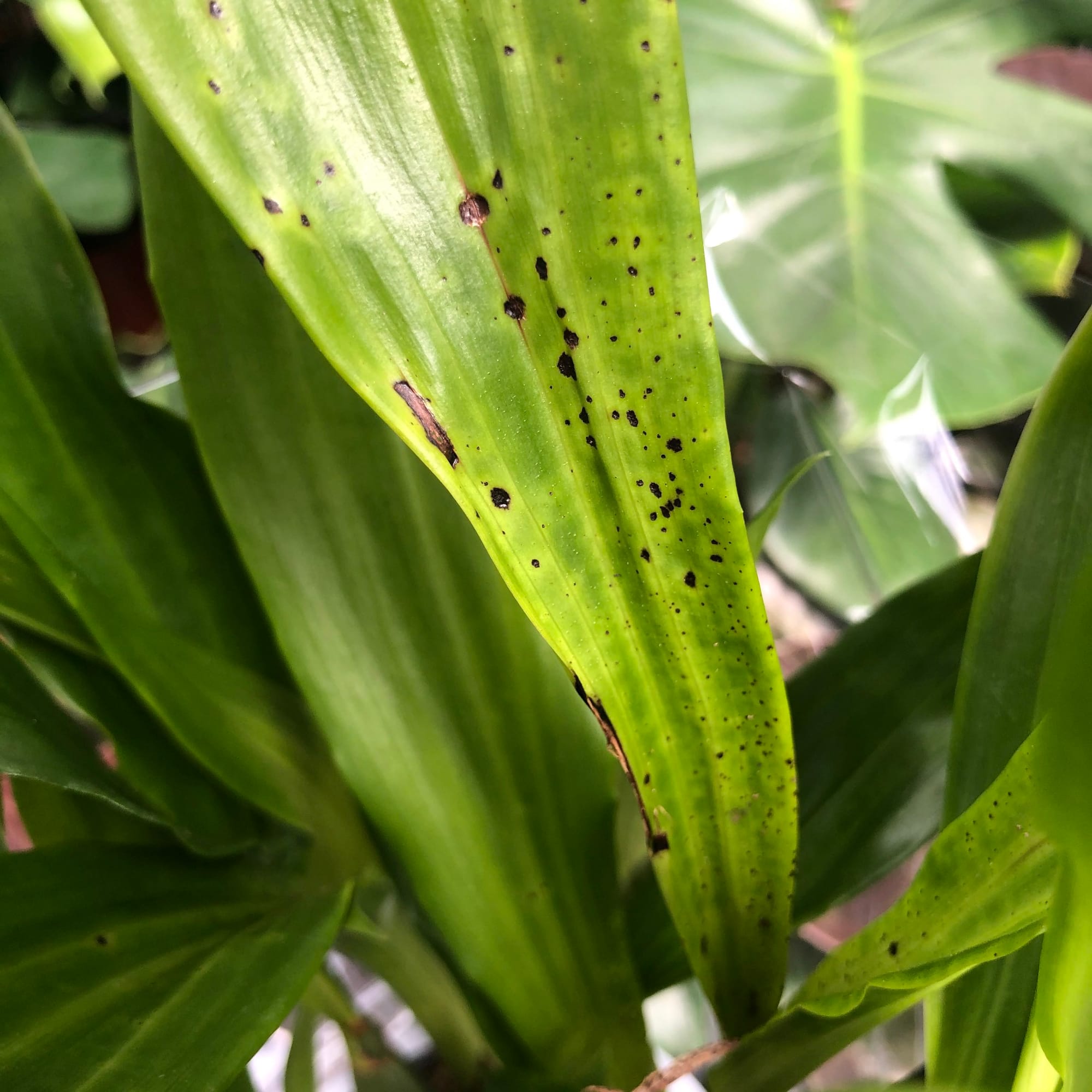 There are several species of Leaf-Spot Disease, (Graphiola, Botrytis, Anthracnose & Cercospora) with all operating similarly. Fungi spores will land on the leaf's surface and will slowly develop along with the plant. Unfortunately, as there aren't any products that'll address the issue head-on, you can only remove the affected areas and regularly wash the leaves to limit the spread. Keep the plant away from unaffected specimens for at least a month after the last symptom.
There are several species of Leaf-Spot Disease, (Graphiola, Botrytis, Anthracnose & Cercospora) with all operating similarly. Fungi spores will land on the leaf's surface and will slowly develop along with the plant. Unfortunately, as there aren't any products that'll address the issue head-on, you can only remove the affected areas and regularly wash the leaves to limit the spread. Keep the plant away from unaffected specimens for at least a month after the last symptom.
Total flower loss can be caused by an array of different issues, including a change in location, too little hydration, too hot or cold temperatures or droughts and pests. While the plant is in bloom, keep the bark evenly moist to hydrate the thirsty work of producing flowers. Locations that are outside of the recommended temperature bracket (below), or have drastic fluctuations must also be kept off the cards. Alternatively, a setting that offers similar temperatures all year round can inhibit blooms. They'll respond very well if the autumn and winter months are a couple of degrees cooler than in summer. In essence, this will not only winterise the plant, but it'll also force it into a dormancy period which is a crucial ingredient for successful flowers. The final issue is pests. Although it's highly unlikely that an infestation will cause a sudden change in health, have a quick inspection for Spider Mites, Aphids and Mealybugs.
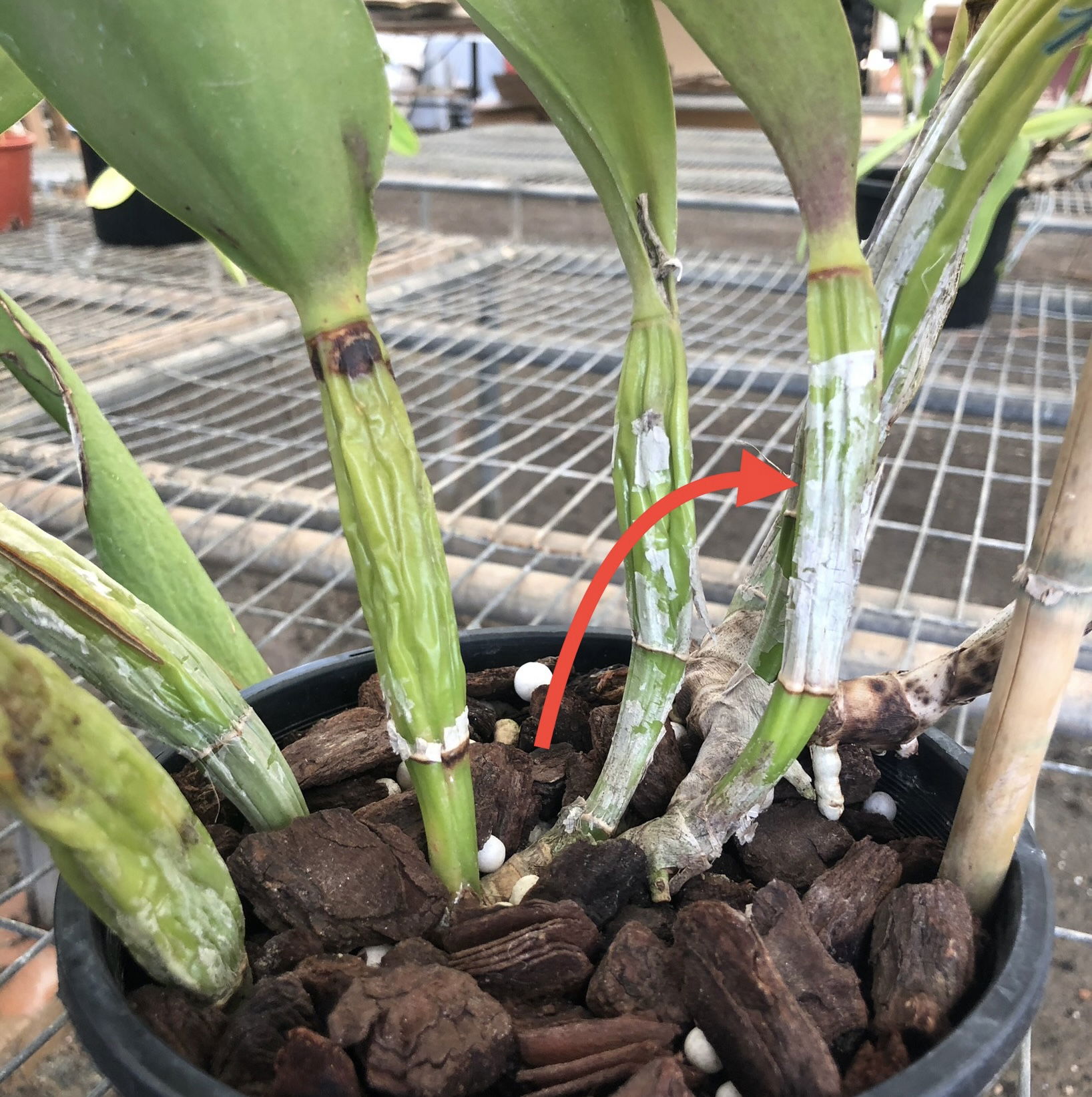 Silver flaky coverings (sheathes) are entirely natural on Cattleya and don't pose any threat to its health.
Silver flaky coverings (sheathes) are entirely natural on Cattleya and don't pose any threat to its health.
Large quantities of aerial roots that cascade over the pot shouldn't cause concern. Once the flowers have fully elapsed, take the plant out of its pot and remove any brown roots when repotting into a bigger pot. If there are a couple still above the soil, either direct them face-down into the compost or allow them to carry on cascading. Be sure to mist the aerial roots while watering the bark to ensure sufficient hydration. If they begin to split, it's the result of too little water or humidity or sun-scorch. Remove once they've fully yellowed over.
Botrytis Petal Blight are small spots or patches that'll develop on the flowers' bodies, usually caused by misting or an over-humid location with poor air circulation. Remove the infected flowers or the complete stalk with sterile utensils to put a stop the airborne disease. Improve the air circulation and move to a slightly brighter location with no direct sunlight. Be careful not to saturate the flowers from there on in, and regularly inspect to see if it has spread. Click here for more info - Common Orchid Diseases
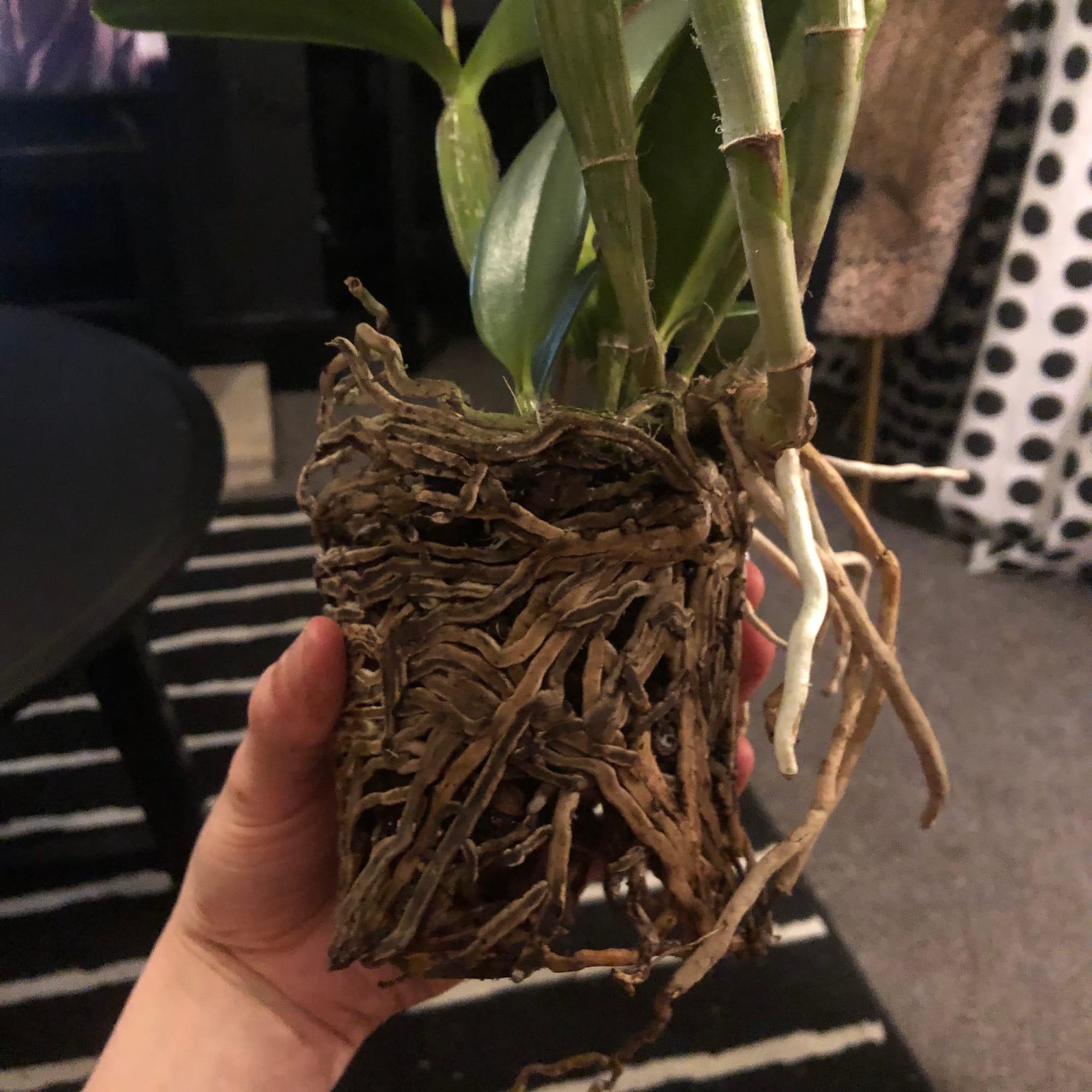 Root Rot on a Cattleya.
Root Rot on a Cattleya.
Origins
Cattleya is a genus of forty-five, rhizomatous species that have natural distributions over south America. It was first described in 1824 by John Lindley after British horticulturalist, William Cattley, who had discovered the most popular species, C. labiata, seven years prior in Brazil. The species' name, 'labiata', refers to the lip-shaped labellum that acts as the 'landing pad' for airborne pollinators.
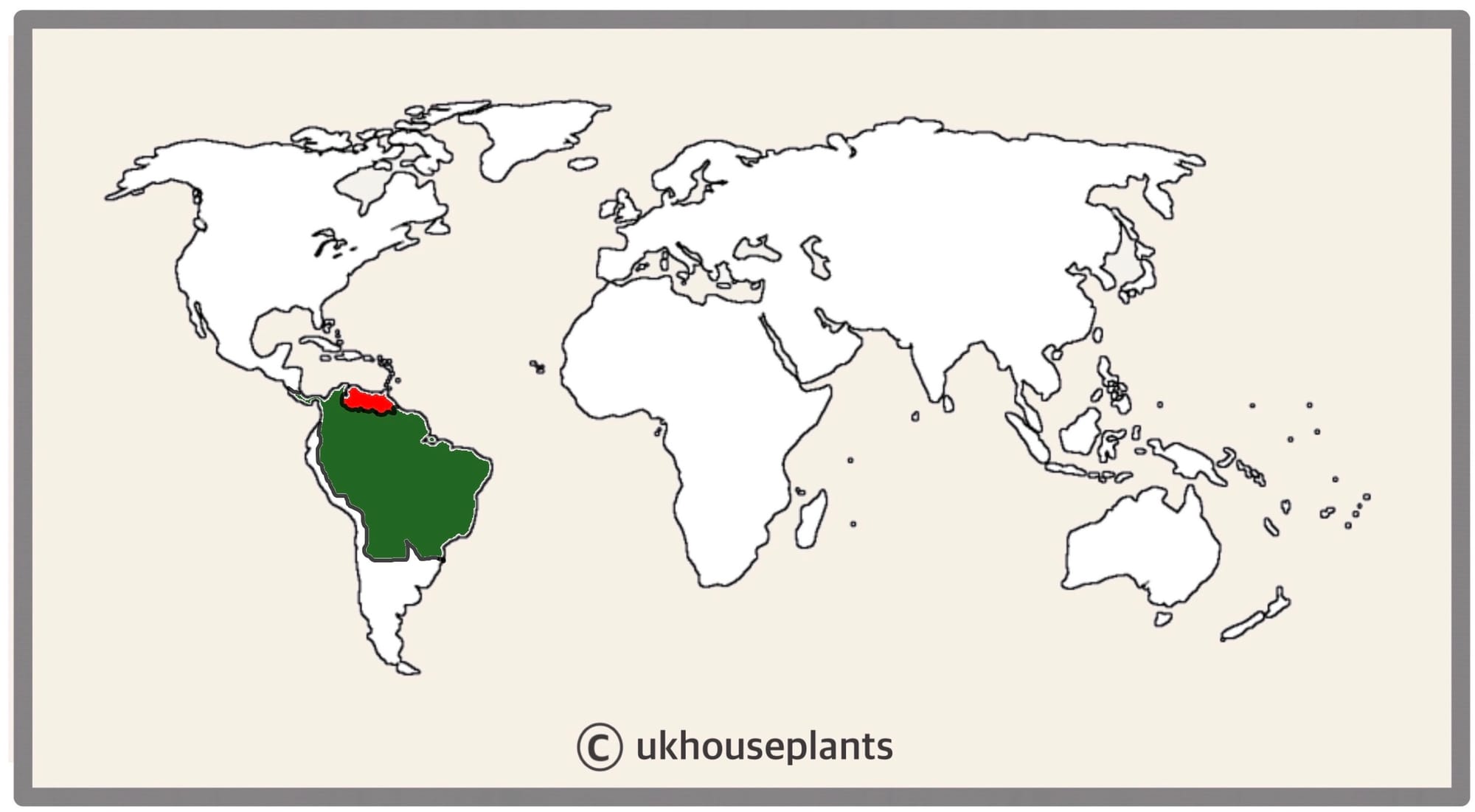 The Distribution of Cattleya in green, & C. labiata in red.
The Distribution of Cattleya in green, & C. labiata in red.
Temperature
10° - 27°C (50° - 80°F)
H1b (Hardiness Zone 12) - Can be grown outdoors during the summer in a sheltered location with temperatures above 12℃ (54℉), but is fine to remain indoors, too. If you decide to bring this plant outdoors, don't allow it to endure any direct sunlight as it may result in sun-scorch and dehydration. Regularly keep an eye out for pests, especially when re-introducing it back indoors.
Spread
Up to 1m in height & 60cm in width, with maturity being achieved in around 5 - 8 years. Two or three new pseudo-bulbs will develop over the course of the year, potentially readying themselves for a bloom within the same season.
Pruning & Maintenance
Remove yellow or dying leaves, and plant debris to encourage better-growing conditions. While pruning, always use clean scissors or shears to reduce the chance of bacterial and fungal diseases. Never cut through yellowed tissue as this may cause further damage in the likes of diseases or bacterial infections. Remember to make clean incisions as too-damaged wounds may shock the plant, causing weakened growth and a decline in health.
Cut and separate any rotten pseudobulbs that are located at the base of the plant. Never remove those that lack leaves but are still green and plump, as they'll produce other pseudo-bulbous offsets.
Propagation
Via Seed & Pseudo-Bulbous Offsets.
Seed Propagation (Very Difficult) - Obtaining and sowing of seeds is both problematic and near-impossible without the correct equipment. Sow on a seaweed-based agar in an enclosed transparent tub on some bottom-heat (25℃, 77℉). Do not open the container until the seedlings are around two inches in height with adequate roots. Pour water into the agar to loosen it off the roots, and pot them up into 5cm (2 inches) pots with Orchid Bark. Maintain high humidity and bright indirect light to alleviate the severity of environmental shock, which can be achieved using a pebble tray. Follow the care requirements mentioned at the top.
Pseudo-Bulbous (Basal) Offsets (Easy When Treating the Specimen with Respect) - It's best to divide during the spring with plantlets that are at least a third of the size of the mother plant with several developed roots. Take the plant out of its pot and place your fingers in between the two bulbs; soil may have to be removed to get a better grip. While placing your hand closely to the nodal junction, gently push the pup downwards and support the mother plant - you should hear a snap. Cautiously separate both the mother plant and pup's roots systems, keeping great empathise in keeping the roots intact and undamaged. Place the new plantlet in Orchid Bark, much similar to the original soil, and maintain the same care routines. Be sure not to use a pot that is too big as a ratio of roots-soil that leans much towards the latter will cause root rot.
Flowers
Autumn flowers will only appear on new basal pseudobulbs that'll emerge from the spring previous. Each spike will reach around 30cm in height and will only house a couple of flowers. The individual blooms can last up to four weeks, and its longevity will solely rely on your cultivation. They're sweetly scented and may sport lavender, white, yellow, pink, orange or red appearances. Achieving a new flower spike isn't as straight forwards as a Moth Orchid, for instance, as each offset will only bloom once, so you may have to wait until the following year for an inflorescence.
Repotting
Infrequent transplants will restrict its growth for a potential bloom. They'll be under threat by the challenging environment, and as they'll potentially die (so they think) a flower shaft will be produced to pass on its genes to the next generation.
Repot every three years (& when not in flower) in spring using Orchid Bark and the next sized pot with adequate drainage. Don't worry if you snap the Velamen (white spongy epidermis) that covers the roots as it'll re-fuse again within the following few weeks. Hydrate the plant 24hrs before the tinkering with the roots to prevent the risk of transplant shock. For those that are situated in a darker location, add a thin layer of small grit in the pot's base to improve drainage and downplay over-watering. Click here for a detailed step-by-step guide on transplantation, or via this link to learn about repotting with root rot.
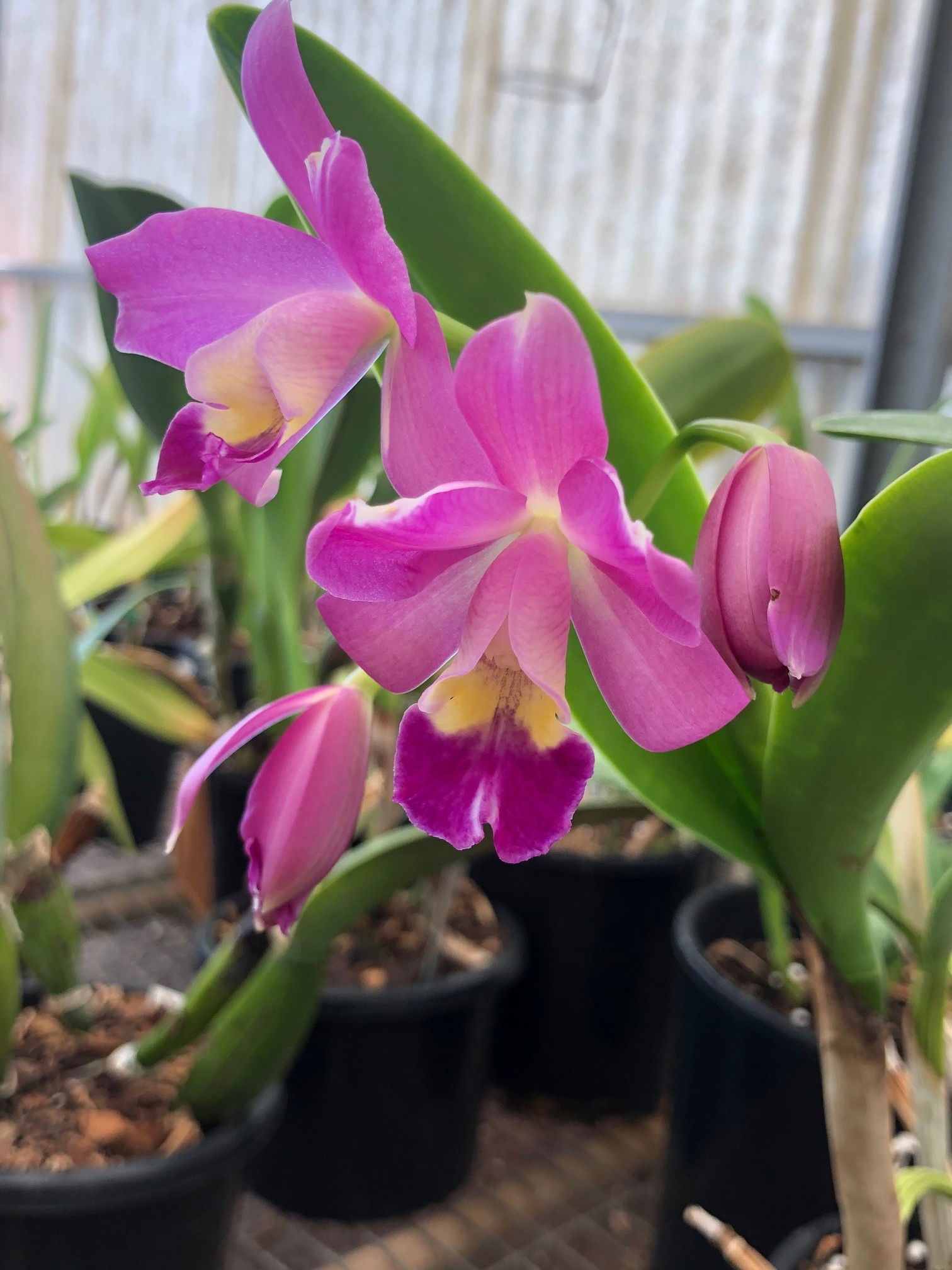 Laeliocattleya kindee 'The King' x scarletimp 'Amy'
Laeliocattleya kindee 'The King' x scarletimp 'Amy'
Pests & Diseases
Keep an eye out for mealybugs, spider mites, scale, thrips & root mealybugs that'll locate themselves in the cubbyholes and undersides of the leaves, except for the latter in the soil. Common diseases are root rot, leaf-spot disease, rust, mosaic virus (brown or purple spots on the leaves), black rot, botrytis petal blight, powdery mildew & southern blight - click here to learn more about these issues.
Toxicity
Not known to be poisonous by consumption of pets and humans. If high quantities are eaten, it may result in vomiting, nausea and a loss of appetite.
Retail Locations
Very few garden centres will unreliably stock Cattleya; search online for a potential purchase.
Book a 1-to-1 Call with THE HOUSEPLANT DOCTOR™
If you need further advice with your houseplants, book an advice call with ukhouseplants' friendly and expert writer today! This can be done via a video or audio call on most apps, including Facebook, FaceTime & Skype. A ten-minute call costs £5.99 (US$7), or £15.99 for thirty minutes. You can ask multiple questions, including queries on plants, pests, terrariums, repotting advice and anything in between. Please consider supporting this service to keep ukhouseplants thriving!